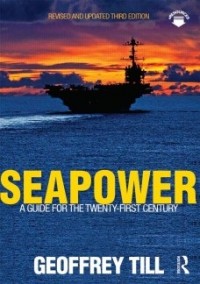Seapower: A Guide for the Twenty-First Century, 3rd Edition
By: Geoffrey Till
London and New York: Routledge, 2013
Geoffrey Till is Professor Emeritus of Maritime Studies in the Defence Studies Department at King’s College, London, and Director of the Corbett Center for Maritime Policy, King’s College London, at the U.K. Joint Services Command and Staff College. He is a prolific writer on maritime and strategic affairs, and he also edits Routledge’s series ‘Naval Policy and History’, of which this volume is a part.
Seapower: A Guide for the Twenty-First Century first appeared in 2004; the present, third edition carries a new introductory chapter that presents the four attributes of the sea (as a resource, and as a medium of transportation, information, and for dominion) and ends by essaying a definition of seapower (a term introduced by Alfred Mahan [d.1914] but left by him undefined). It does so by distinguishing seapower inputs (its constituents such as navies) from seapower outputs (its consequences). This makes plain the broad sweep of this volume, which has also been revised and updated, with the most recent tensions involving the South China Seas reviewed in a special case study (Ch.13).
The author favours theory because in the modern naval view “the absence of theory is far more likely to stultify action than its presence” (p.46). He sees Mahan, and Sir Julius Corbett (d.1922) as the major theorists of this field. However, Till makes it a point to distinguish between Mahan’s ‘naval’ strategy – offensive, aiming at a decisive battle – that still retains considerable relevance, and Corbett’s broader ‘maritime’ approach (with Clausewitzian overtones), which argues that maritime strategy has to be seen not as a separate entity, but “simply as part of the art of war” (p.64): the overall plan for utilising means of coercion.
For students of international relations the most relevant chapter might well be the second, which sets the tone for the book and is entitled ‘Seapower in a Globalizing World: Two Competing Approaches’. Till believes that globalisation is shaping a new paradigm for collaborative sea power: it encourages a ’borderless world’, powered by a dynamic world economy that requires free shipping but is also increasingly vulnerable to disruption. Post-modernists assume that globalisation will continue but must be defended against a variety of threats. Modernists, by contrast, argue that war and warfare will are permanent features of the system and deny that defence preparations can be based on ‘cosy’ expectations of a collaborative outcome.
These competing outlooks on the future produce two distinct visions of the role of seapower in the 21st century: the modern navy that is nation-state-centric, and the post-modern navy that is system-oriented. For the modern navy, the priorities are sea control, nuclear deterrence, power projection, exclusive good order at sea, and competitive gunboat diplomacy. The post-modern navy is “at the heart of the globalization process” (p.35), by maintaining its security and carrying out system-defence tasks: making the sea secure for all, carrying out expeditionary and stability operations; engaging in “gunboat philanthropy”, fostering inclusive good order, and “commanding” the global commons in a cooperative fashion. While most navies exhibit a blend of these characteristics, the maritime policies of Singapore, or Sweden, are cited as good examples of the post-modern tendencies.
While this study of seapower is presented as a guide to the 21st century, it also admits that the respective weight of competitive and collaborative features of naval developments is “impossible to predict” (p.339). While the standard aspects of the subject (such as command of the sea, technology, naval diplomacy) are reviewed at considerable length, there is no discussion of the global wars that have shaped the modern world system, in large part via an exercise in seapower. Are such “major wars between advanced states” “indeed going out of fashion” (p.46)? That is not much of a reassurance, for trends that are in fashion at one time reverse all too easily to being out of fashion. As the author notes in his (rather tentatively titled) ‘Conclusions?’ (ch.14), “the growth of the navies of the Asia-Pacific seems to contrast most forcefully with the decline of those of West Europe.” “Almost inevitably”, China’s naval developments may be expected to challenge the strategic primacy of the United States, “at a level of competition and conflict that have until now characterized great changes in the relations of great states” (p.340). An examination of some global politics scenarios for the 21st century, including the likelihood of low probability but high impact catastrophic events, could have added strength to this substantial work that otherwise leaves the reader (in the penultimate sentence of the book) with the feeling of a “grossly uncertain future”.
—
George Modelski is Professor Emeritus, Political Science, in the University of Washington, Seattle. He is co-author of ‘Seapower in Global Politics 1494-1993’ (Macmillan 1988).
